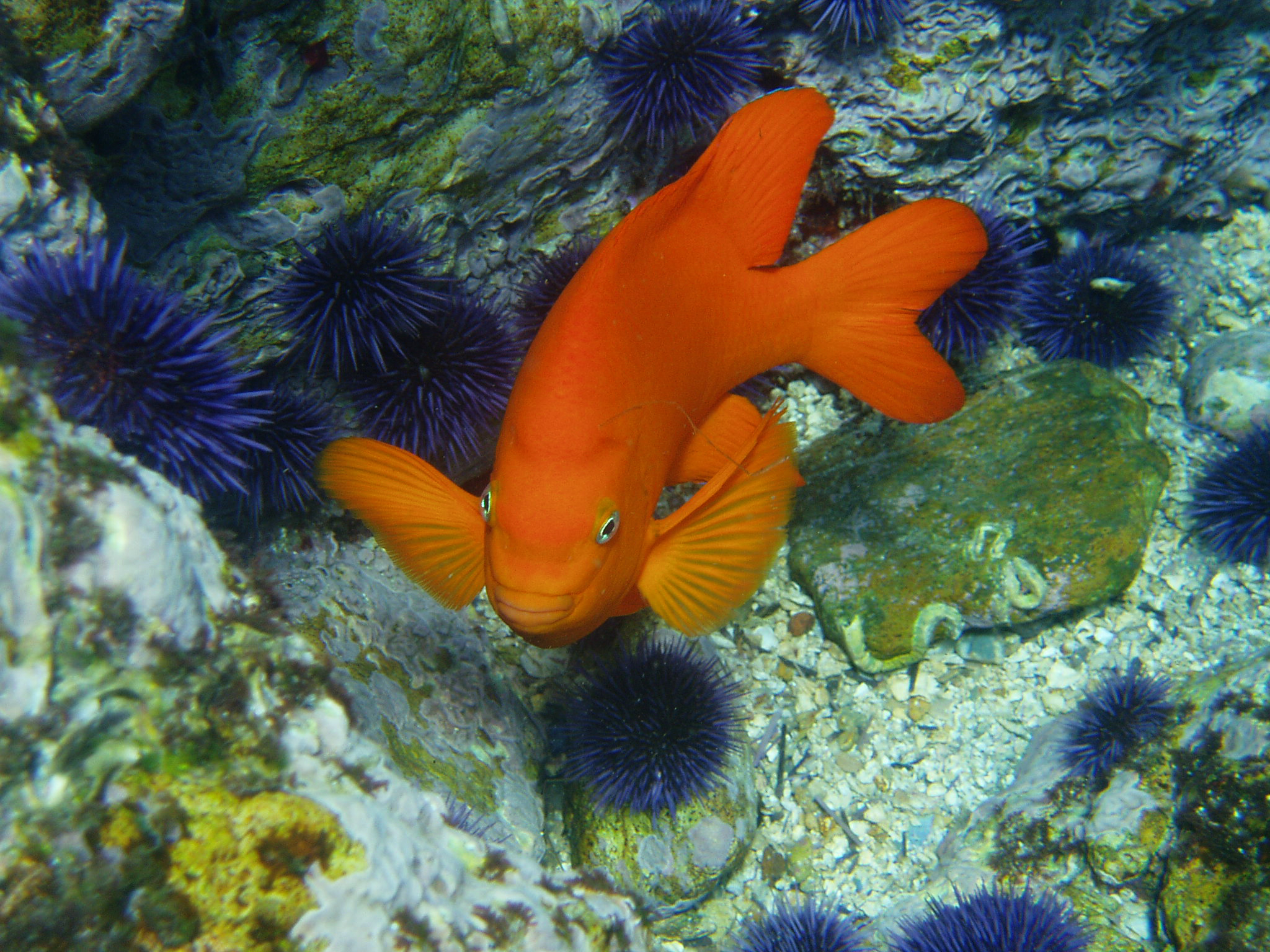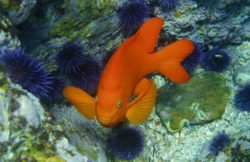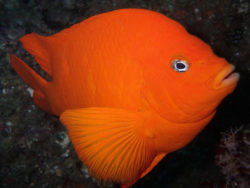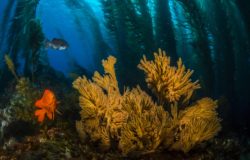
Sea Wonder: Garibaldi

Garibaldi are generally found at around 45 feet or less because their prey also lives in shallower waters. This garibaldi was found in Channel Islands National Marine Sanctuary but they frequent all four of California’s sanctuaries. Photo: Claire Fackler/NOAA
Garibaldi (Hypsypops rubicundus) are vibrant, orange fishes that are part of the damselfish family (Pomacentridae). Their coloration and body features often lead people to mistake them for marine goldfish. In fact, they are so noticeable and stunning that the state of California made them the official state marine fish! Rest assured – even if they do resemble goldfish, you won’t find these beauties offered up as a prize at your local carnival.
Description
The most striking feature of garibaldi is their uniform and bright orange appearance. Juveniles have slightly different coloration, with a deeper red to their overall appearance and electric blue spots all over, including their fins. The blue accents disappear when they grow to be about six inches long and their color continues to transition to the true orange we see in adults as they mature.
Garibaldi are the largest species of damselfish and can reach lengths of 15 inches or more when fully grown and weigh nearly two pounds. Their bodies are ovular in shape and compressed on the sides, meaning the fish are longer than they are wide. They are covered in scales, have lips that are disproportionately larger than their small mouths, and have a heart-shaped tail fin, which they move in a side-to-side motion to swim.
Diet & Habitat

Juvenile garibaldi have a deeper red coloration with electric blue spots all over. As they mature, their blue spots disappear and they transition to a true orange. Photo: Evan Barba
Garibaldi are omnivorous fish with a diet composed mostly of bottom-dwelling invertebrates and algal growth. Prey include marine worms, anemones, sponges, crabs, shrimp, and sea stars. On occasion, females will eat their own eggs. Garibaldi generally hunt during the day and use their protruding lips and teeth to help them pull algae off of surfaces and unsuspecting prey out from under the sediment or beneath rocks. The sponges in their diets may enhance the bright coloration of these fishes. Several larger animals eat garibaldi, including sharks, seals and sea lions, and even birds like pelicans.
Garibaldi are native to waters off the West Coast of North America, specifically in California and Mexico. They prefer subtropical and temperate waters and live on rocky reefs and among kelp beds that are close to the shore. Since their prey lives in shallower waters, so do garibaldi. We generally see them at depths of around 45 feet or less, though they can survive at depths of around 100 feet. In the National Marine Sanctuary System, garibaldi live in or near all four of California’s sanctuaries – Monterey Bay, Channel Islands, Greater Farallones, and Cordell Bank.
Life History
Garibaldi can live to be as old as 20, but 10 to 12 years old is the average lifespan. They reach sexual maturity at five or six years old, with males usually reaching adulthood first. Females are highly selective in choosing mates, so males spend a lot of time building and maintaining nests from algae in preparation. To signal they are receptive to males, females swim with their fins flared out. Males then approach the female, making loud clucking and grinding vocalizations before darting back to their nest in hopes that the female shows interest and follows him. The female inspects the nest and any eggs already laid there before choosing to mate with the male or look for another one. If the two spawn, males chase the female away from the nest almost immediately to prevent her from eating the eggs. Males guard their nests and fiercely protect the fertilized eggs until they hatch. Spawning seasons lasts from March to July each year, and it is possible for individuals to spawn several times with different mates during the season,
Garibaldi eggs hatch about a week after fertilization and hatchlings leave the nest soon after they are born. If they survive into their juvenile life cycle stage, they will find an area to settle and live out their lives. Garibaldi are fairly territorial, defending their nesting sites when threatened, and prefer to live independently from other individuals. While they often live near other garibaldi, these fish do not school and generally only interact to reproduce or spar for space. When not foraging, garibaldi retreat to rocky crevices and other hidden areas for safety.
Threats & Conservation
Data suggests garibaldi populations are stable throughout their home range, though they are sometimes caught by accident in commercial fishing gear and are a popular aquarium fish. The International Union for Conservation of Nature (IUCN) lists them as a species of least concern, and the state of California has laws in place to protect the species, one example of which prohibits takes of garibaldi without a permit. Future threats to the species include habitat loss and degradation, decreasing prey availability, warming and increasingly acidic ocean waters, and physical and chemical pollution.

Garibaldi mainly live in kelp forests, like this one in Channel Islands National Marine Sanctuary, as these complex ecosystems offer food and protection. Photo: Kelly Teich
